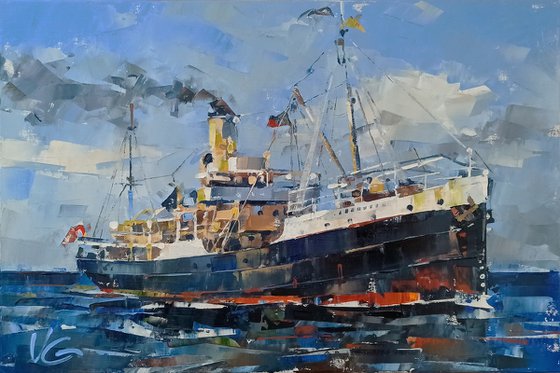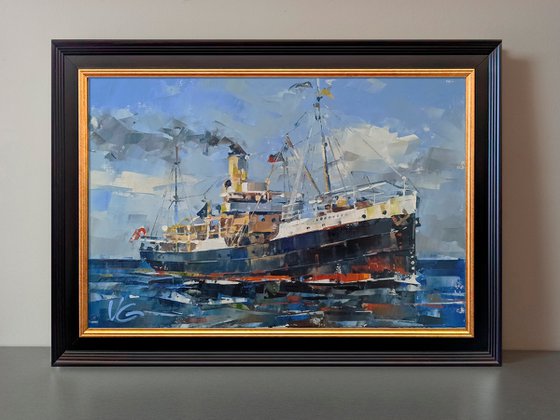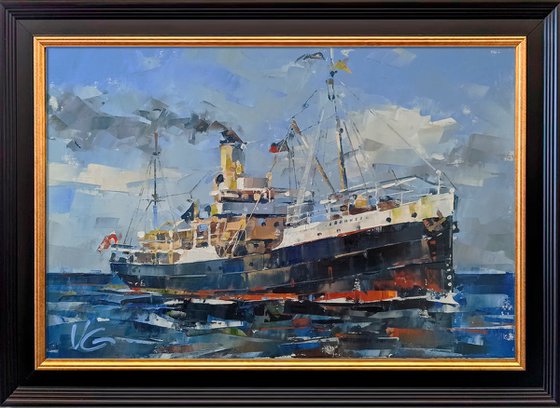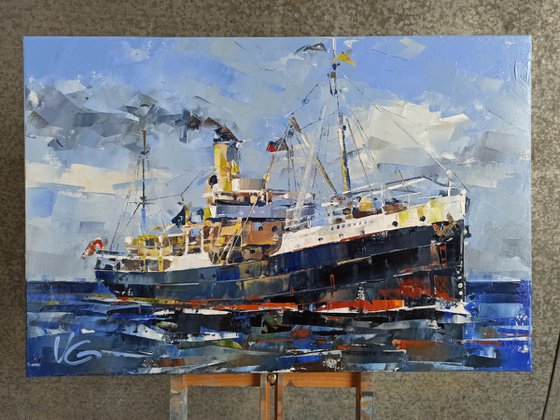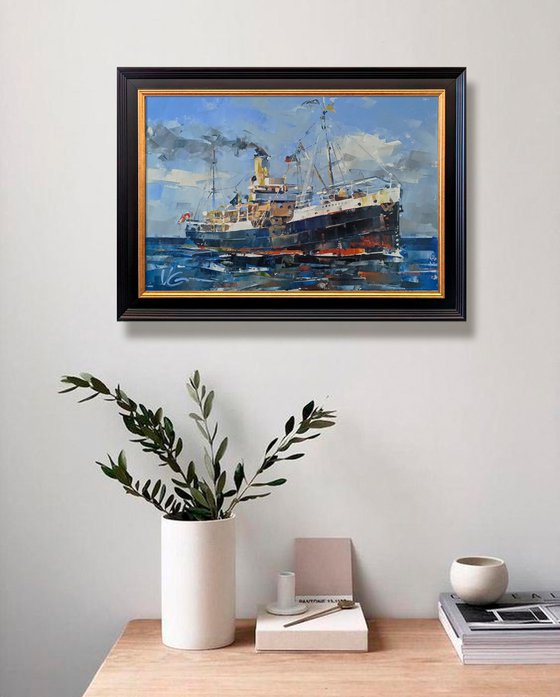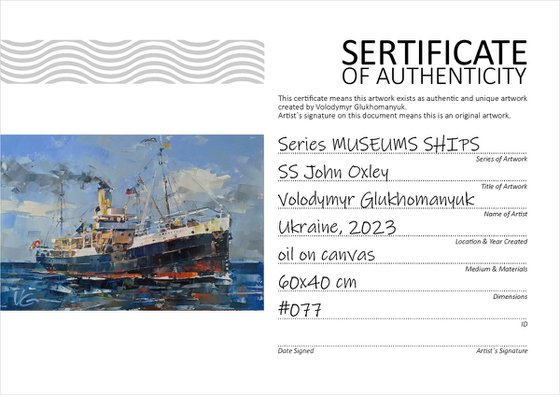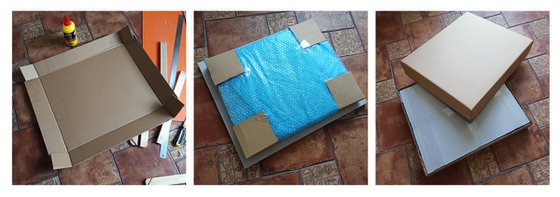- By medium
- By subject
- By budget
- Sales
- Gift cards
- Discover all art
- Artists
- Editors’ picks
- Ideas
Original artwork description:
My series MUSEUM SHIPS is conceived as a picturesque story about unique ships that are still in the service of man. Dynamic shapes, unsurpassed hull contours, majesty of the superstructure - everything has an aesthetically complete design!
My canvases are not only visual content, they are, first of all, amazing stories, a tribute to volunteers and employees, thanks to whom the museum ships exist, and especially to the veterans who served on them.
Welcome aboard!
SS John Oxley is a steamship that previously served as a pilot boat and lighthouse and buoy tender. The ship was built in Scotland in 1927 for the Queensland state government. The vessel was taken into the Royal Australian Navy during the Second World War. Returned to her duties after the war, John Oxley remained active until 1968, when her deteriorating condition made her unusable. In 1970, the ship was donated by the Queensland government to the Lady Hopetoun and Port Jackson Marine Steam Museum (now the Sydney Heritage Fleet) for preservation, but due to other projects, work was sidelined until 2004. As of 2017, the ship is undergoing restoration at Rozelle Bay, Sydney, Australia.
Bow, McLachlan and Company of Paisley in Renfrewshire, Scotland built John Oxley in 1927, under yard number 464.[1] She was launched on 20 July 1927, and completed later that year. The vessel is 168 feet (51 m) long, with a beam of 32 feet (9.8 m), and a draught of 11 feet (3.4 m). Tonnage values are 544 Gross register tonnage, 760 Deadweight tonnage, and 212 Net Register Tonnage Propulsion is provided by two Scotch marine boilers supplying a triple expansion steam engine, which delivers 1,400 IHP to the propeller, for a maximum speed of 14 knots (26 km/h; 16 mph). The vessel had a crew of 15, and in her role as a pilot boat, could carry 14 harbour pilots.
She was delivered to the Government of Queensland Harbours and Marine Department, whom she served as a pilot boat in Moreton Bay and buoy tender and lighthouse tender along the Queensland coast.
In the Second World War John Oxley was requisitioned for the Royal Australian Navy and a 20mm Oerlikon anti-aircraft gun was mounted on the stern. She was returned to her former duties in 1946, and converted from coal to oil fuel that same year.
John Oxley continued to serve as a pilot tender, lighthouse and buoy tender until 1968 when she was decommissioned. In her later years she had become increasingly decrepit, such that in 1964 the Seamen's Union of Australia's journal called her a "rust heap" with "the worst living conditions of any ship on the entire Australian coast".
John Oxley was donated to the Lady Hopetoun and Port Jackson Marine Steam Museum (now the Sydney Heritage Fleet) in 1970. She saw very little repair work until 1997, when restoration on another ship, the barque James Craig, was at a stage where she could be taken off the floating dock. Until then, John Oxley's hull had gradually deteriorated and she was badly in need of repairs when put on the floating dock in place of the James Craig.
Since 2002 the John Oxley has been under continuous restoration at the Heritage dockyard of the Sydney Heritage Fleet, Rozelle Bay, Sydney. During eighty years on the water, the ship had incurred substantial corrosion to the hull, decks and superstructure. The majority of the plates of the ship's riveted hull have required complete replication using the same hot riveted method as when the ship was built.
The restoration work also entails the repair and reconditioning of all machinery, masts and rigging, timberwork, internal fitout and generally making the ship seaworthy so she can be put back into survey and make coastal voyages.
Materials used:
oil on linen, palette knife
Tags:
#australia #sydney harbour #royal navy #steamboat #second world #custom painting #steamer #cargo ship #puffer #coastal voyagesSteam Ship SS JOHN OXLEY (2022) Oil painting
by Volodymyr Glukhomanyuk
£1,360.17
- Oil painting on Canvas
- One of a kind artwork
- Size: 60 x 40 x 2cm (unframed) / 60 x 40cm (actual image size)
- Ready to hang
- Signed certificate of authenticity
- Style: Impressionistic
- Subject: Landscapes, sea and sky
Loading
Original artwork description
My series MUSEUM SHIPS is conceived as a picturesque story about unique ships that are still in the service of man. Dynamic shapes, unsurpassed hull contours, majesty of the superstructure - everything has an aesthetically complete design!
My canvases are not only visual content, they are, first of all, amazing stories, a tribute to volunteers and employees, thanks to whom the museum ships exist, and especially to the veterans who served on them.
Welcome aboard!
SS John Oxley is a steamship that previously served as a pilot boat and lighthouse and buoy tender. The ship was built in Scotland in 1927 for the Queensland state government. The vessel was taken into the Royal Australian Navy during the Second World War. Returned to her duties after the war, John Oxley remained active until 1968, when her deteriorating condition made her unusable. In 1970, the ship was donated by the Queensland government to the Lady Hopetoun and Port Jackson Marine Steam Museum (now the Sydney Heritage Fleet) for preservation, but due to other projects, work was sidelined until 2004. As of 2017, the ship is undergoing restoration at Rozelle Bay, Sydney, Australia.
Bow, McLachlan and Company of Paisley in Renfrewshire, Scotland built John Oxley in 1927, under yard number 464.[1] She was launched on 20 July 1927, and completed later that year. The vessel is 168 feet (51 m) long, with a beam of 32 feet (9.8 m), and a draught of 11 feet (3.4 m). Tonnage values are 544 Gross register tonnage, 760 Deadweight tonnage, and 212 Net Register Tonnage Propulsion is provided by two Scotch marine boilers supplying a triple expansion steam engine, which delivers 1,400 IHP to the propeller, for a maximum speed of 14 knots (26 km/h; 16 mph). The vessel had a crew of 15, and in her role as a pilot boat, could carry 14 harbour pilots.
She was delivered to the Government of Queensland Harbours and Marine Department, whom she served as a pilot boat in Moreton Bay and buoy tender and lighthouse tender along the Queensland coast.
In the Second World War John Oxley was requisitioned for the Royal Australian Navy and a 20mm Oerlikon anti-aircraft gun was mounted on the stern. She was returned to her former duties in 1946, and converted from coal to oil fuel that same year.
John Oxley continued to serve as a pilot tender, lighthouse and buoy tender until 1968 when she was decommissioned. In her later years she had become increasingly decrepit, such that in 1964 the Seamen's Union of Australia's journal called her a "rust heap" with "the worst living conditions of any ship on the entire Australian coast".
John Oxley was donated to the Lady Hopetoun and Port Jackson Marine Steam Museum (now the Sydney Heritage Fleet) in 1970. She saw very little repair work until 1997, when restoration on another ship, the barque James Craig, was at a stage where she could be taken off the floating dock. Until then, John Oxley's hull had gradually deteriorated and she was badly in need of repairs when put on the floating dock in place of the James Craig.
Since 2002 the John Oxley has been under continuous restoration at the Heritage dockyard of the Sydney Heritage Fleet, Rozelle Bay, Sydney. During eighty years on the water, the ship had incurred substantial corrosion to the hull, decks and superstructure. The majority of the plates of the ship's riveted hull have required complete replication using the same hot riveted method as when the ship was built.
The restoration work also entails the repair and reconditioning of all machinery, masts and rigging, timberwork, internal fitout and generally making the ship seaworthy so she can be put back into survey and make coastal voyages.
Materials used:
oil on linen, palette knife
Tags:
#australia #sydney harbour #royal navy #steamboat #second world #custom painting #steamer #cargo ship #puffer #coastal voyages14 day money back guaranteeLearn more
